DjangoBooks.com
Welcome to our Community!
Categories
- 20K All Categories
- 1.1K General
- 477 Welcome
- 59 Archtop Eddy's Corner
- 146 CD, DVD, and Concert Reviews
- 385 FAQ
- 26 Gypsy Jazz Italia
- 27 Photos
- 202 Gypsy Picking
- 21 Unaccompanied Django
- 15 Pearl Django Play-Along Vol.1
- 17 Gypsy Fire
- 45 Gypsy Rhythm
- 1.4K Gypsy Jazz University - Get Educated
- 131 Gypsy Jazz 101
- 227 Repertoire
- 219 History
- 708 Technique
- 51 Licks and Patterns
- 6 Daniel Givone Manouche Guitare Method Users Group
- 20 Eddie Lang Club
- 1.3K Gypsy Jazz Gear
- 802 Guitars, Strings, Picks, Amps, Pickups and Other Accessories
- 460 Classifieds
- 49 Recording
- 62 Other Instruments
- 18 Violin
- 5 Mandolin
- 22 Accordion
- 7 Bass
- 10 Woodwinds
- 348 Gypsy Jazz Events
- 143 North America
- 110 Europe
- 95 International
In this Discussion
Who's Online (0)
The Return Of The Mystery 'Sonora' Tailpiece
 ChrisMartin
Shellharbour NSW Australia✭✭ Petrarca, Hofner, Burns, Kremona Zornitsa, Fender, Epiphone
ChrisMartin
Shellharbour NSW Australia✭✭ Petrarca, Hofner, Burns, Kremona Zornitsa, Fender, Epiphone
I recently picked up a fairly ordinary looking parlor size guitar with the label identifying it as by Luigi Genovesi of Catania Sicily. Not much info out there, he seems to have been most active in the 1920s and '30s. Was he still making guitars in the 1950s? Certain clues would seem to suggest so, the tailpiece for one.
It was cheap enough for a fun restoration project but I bought it as much for the tailpiece as any other ideas of finding a great guitar.
But when I removed it I found the three screw holes were the only holes there, meaning it had probably been on there from new, I had been thinking it had been added somewhere along the years as parts often do get swapped around but no, the evidence is that it is original to the guitar.
So why such an elaborate tailpiece on an otherwise plain guitar, although I may be selling it short there, the scratchplate is missing and it may have been highly decorated which would have enhanced the appearance somewhat, and maybe Genovesi guitars were not the cheapest in town.
All speculation of course.
So what is this tailpiece and who made them?
Cast in aluminium (or aluminum as Americans call it) with the distinctive treble clef motif in the centre, other similar ones have been seen without the clef, just an open triangle shape, or were these just maybe the same thing where the middle had broken away?. One would think to cast these would have been more work - and expense - than the more common stamped parts.
First we have the Sonora connection: These tailpieces have often been seen on Sonora branded guitars and there has been much discussion about these on this forum in the past. Sonora was not a manufacturer, just a retail brand. Speculation suggests that some were made by Busato but that may have been just wishful thinking to try to boost their value, although certain traits of the round hole model as made famous by Hono Winterstein seem to fit. Certainly, as I had posted in the past it is possible and by the mid-fifties Pierre Fontaine had been sub-contracted to make the more basic guitars for Busato so maybe that is a connection. Others had suggested they came from Carmelo Catania or Jacobacci.
Then there are the mysterious 'Jose Sanchez' guitars one of which possibly also had the same tailpiece. Sanchez appears to have been a fictitious Spanish luthier whose brand was attached to guitars sold by Gaillard et Loiselet a musical instrument manufacturer/wholesaler and retailer based at 273 Cours Lafayette, Lyon with shops in that city and possibly others. They are best known for drums and brass instruments but bought guitars in from other manufacturers. Certainly they bought many from Jacobacci.
So now we have a guitar from another of the Sicilian luthiers in Catania, Luigi Genovesi with a distinctive tailpiece apparently as an original fitting.
Any other suggestions?
I had thought I could sell this on to someone who may want to restore a more typically 'manouche' style Sonora, (offers over $100 anyone?) but then again I may just restore the Genovesi and see how the finished guitar looks then.
The Genovesi as bought.
Close up of the tailpiece.
And a more common model by Sonora.


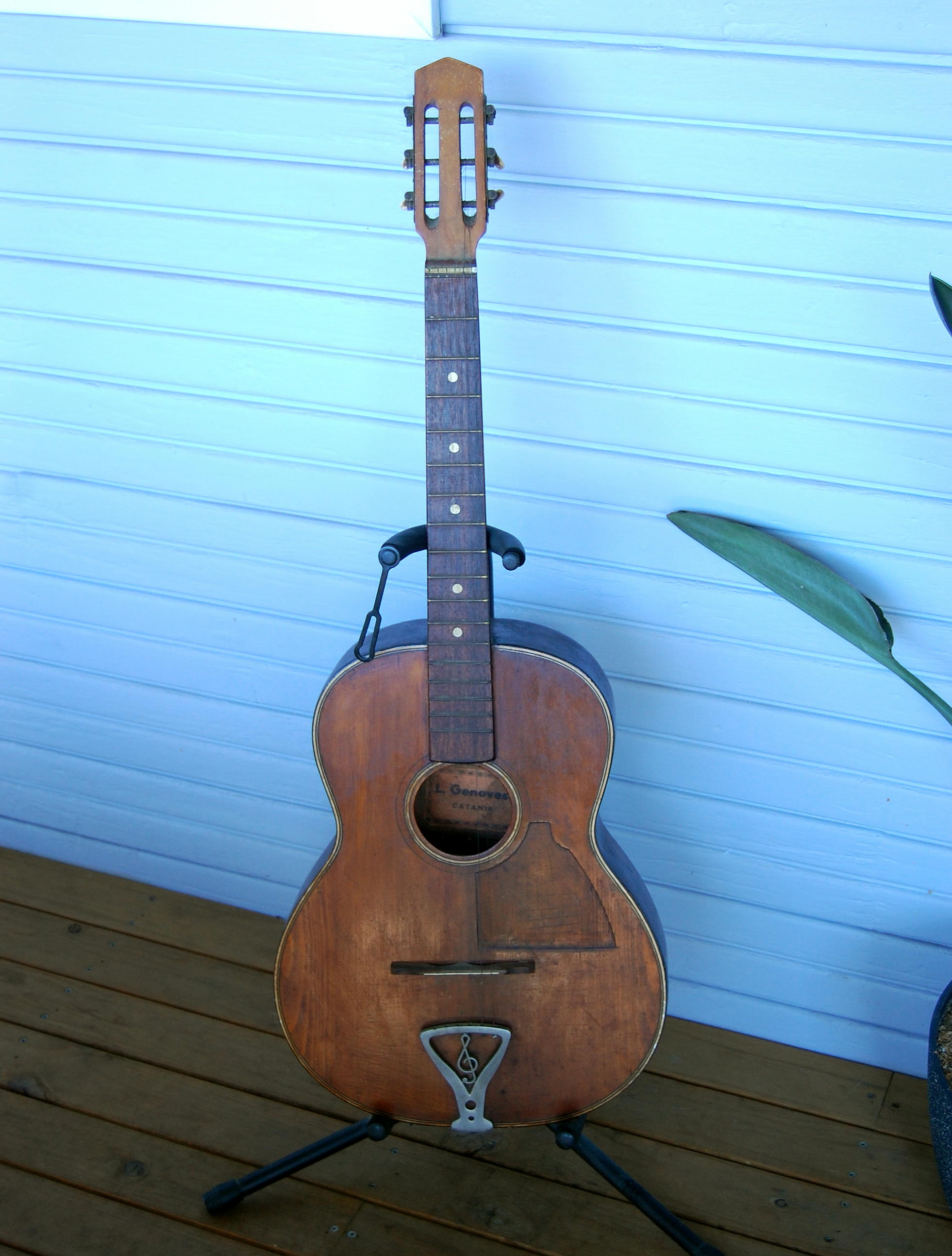
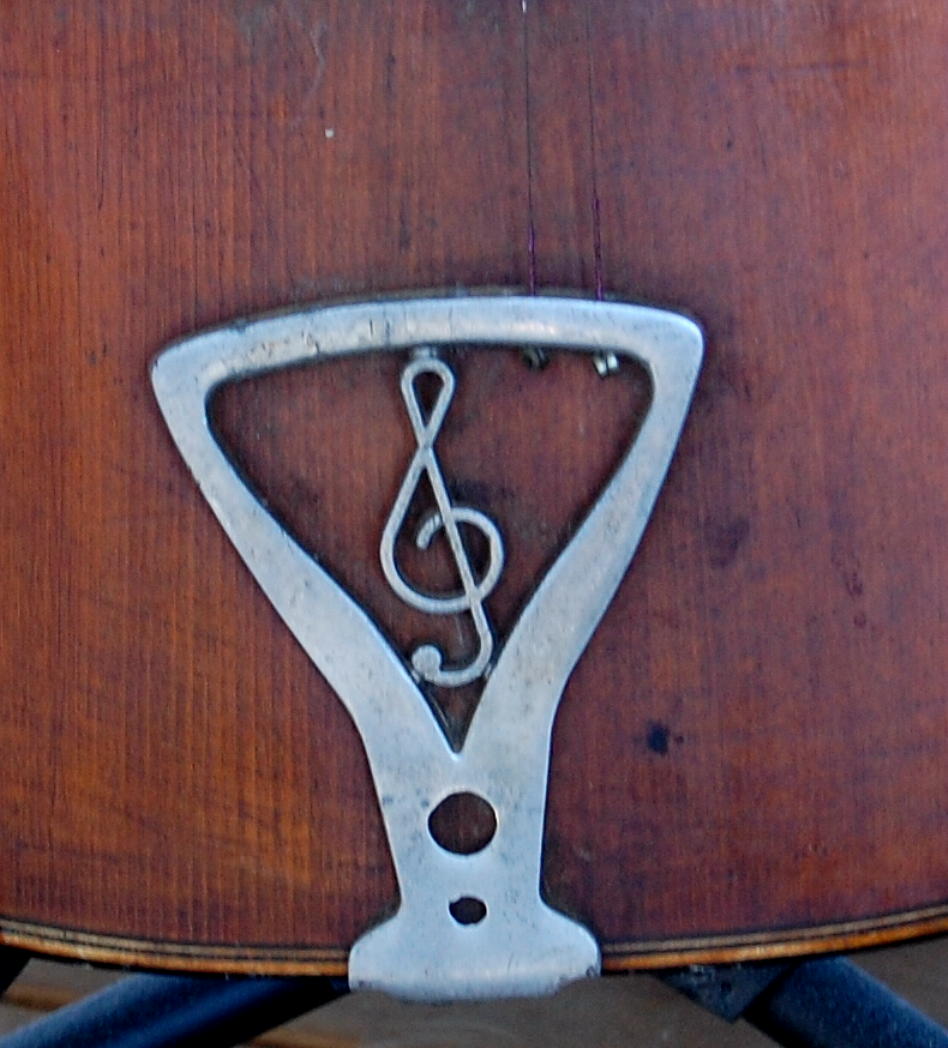
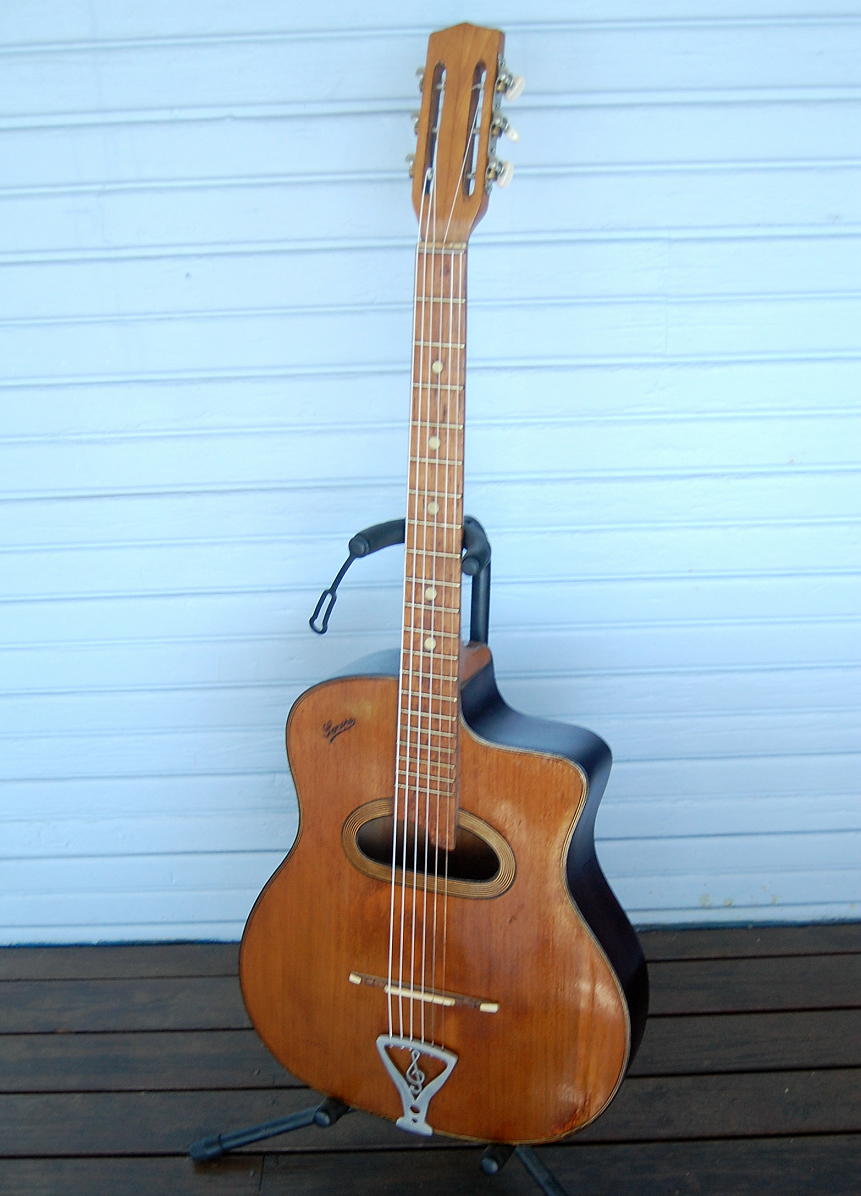
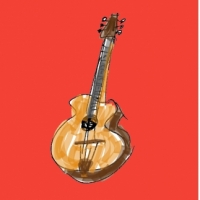
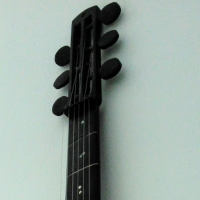

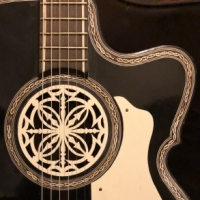








Comments
I think I have a folder full of Sonora pictures, maybe this thread is the place for them...
Of course this mystery builder's 🎼-tail Selmer-style guitars often turn up without the "Sonora" brand, or any labelling, as above- I still think of them as French-made - the 13.5 fret necks, multiple soundhole inlay strips and the Delaruelle tuners are unlike anything commonly seen on seen on Sicilian instruments, although these simple bridges do look Italian. There's a possibility that a previous owner got lucky with the screw spacing when upgrading your tailpiece, or that Genovesi acquired a small batch of these cast tailpieces. It would be interesting to compare the two models side-by-side. Looks like an enjoyable little restoration project , Chris, I hope it's a keeper.
Yes, there have been several the same as that one seen both with and without the Sonora branded mark. Also, at least one with the Jose Sanchez label for Gaillard et Loiselet. Of course any of these may have been changed too so nothing is guaranteed. There are also other guitars branded Sonora with and without the same tailpiece and with various claims as to their origins although the famous round-hole one played by Hono Winterstein does have a Busato look about the decoration on the scratchplate at least. Many other Sonoras have been seen with other, different, tailpieces, although again we can never know which are original to which guitars.
Anyway, I was hoping not to get too tied up in the Sonora debate this time, but if AndyW wants to start a new thread to investigate that can of worms, then go for it, I also have many different Sonora photos on file. My intention with posting this here is it seems that whoever did make these tailpieces, both with and without the treble clef, they were not necessarily exclusive to Sonora and as it is already agreed that Sonora was a retail brand not a manufacturer, we have to look elsewhere.
And yes, I agree the Sonoras shown above do appear to be more likely made in France than Sicily although yes, that tiny bit of decoration on the bridge (mine has the same as the one you posted) is typically Italian. I know of at least one other identical here in Australia too. Another question might be to identify the tuners, but again these are often changed down the years, the only clue being they are not always fitted with the typical yellow button Delaruelle tuners common to many Paris based luthiers.
I also have many photos of other Sonora branded guitars, all different, and all with different (but more common in France) stamped tailpieces.
So, to sum up the Sonora connection, my guess is these were made by various manufacturers in both France and Italy and possibly often supplied as a bare body and neck combination to be assembled with bought in tuners, tailpieces, bridges and maybe scratchplates too.
Meanwhile back to the tailpiece, how many other guitars are out there with this type fitted that have come from a known source? And how many of those can be 100% proven to be made in either Italy or France?
As for my Genovesi, he was definitely active in Catania and as I said on this guitar the holes match up to the only holes in the body so it is almost certainly original to the guitar. The three mounting holes are grouped in a much smaller triangle than is normal and I have included a photo showing the difference with some other more common types.
All very trivial I know, but considering we are not trying to solve the mystery of the pyramids who made what and where in the second half of the 20th century should not be so hard to ascertain should it?
A different version of the cast aluminium tailpiece on this "Luciano Grimaldi"guitar, made in Catania, Sicily.
Different inlays aside, does this resemble your Genovesi, Chris ??
Cool tailpiece. Are they available to purchase new? thx
I very much doubt it.
The point of this post was to see if anyone knew who made them or where they came from, but the are usually only found on guitars that appear to be from the 1950s or possibly '60s.
That is a slightly different variation on the same idea again but one would think from the basic outline that it also came from the same source.
And does my Genovesi resemble your Grimaldi?
Not really, both the same basic outline but while the Grimaldi has the centred scratchplate, mandolin style, my Genovasi has the offset scratchplate on the treble side (or rather, it doesn't, as it has long gone missing) but that is the question of decoration that I was referring to in the first post.
The Grimaldi in that photo is attractively decorated and could carry a more extravagant tailpiece well but from what I have seen of the extremes of decoration on Sicilian instruments, the lack of any fancy rosette would seem to indicate my Genovesi would have been a fairly basic model yet it still retained a taipliece that must have cost more to make (and therefore buy in) than the more common stamped item.
By the way, I will be asking for ideas for a design for a scratchplate that I could maybe make up by cutting, filing and gluing, or any help or tips as to how to get started in that direction.
Is it just me that sees familiar looking design / typography on the label ?
Maybe they're just sharing the same local printer, or maybe a closer connection...
Yeah, I already thought that, but then came to the same conclusion, they may have only had one or two printer shops in town, and they did not have much imagination or see the need to come up with anything too flash - leave that to the Puglisis and Miroglios. I did not imagine there was any more sinister motive than that for the similarity.
The Genovesi is currently on the bench in the shed having some tired old shellac stripped and the crack in the back investigated for a better repair but I have to be careful to work around the label to keep that intact. Tuners cleaned in hydrogen peroxide but I don't know if I can find two matching buttons or will need to replace the whole set. Frets will polish up ok.
Still looking for ideas for scratchplate, do you have any photos of old Sicilians with a piece roughly that shape that might give me inspiration?
Will report back
heya Chris - send me a picture or two of the old tuner buttons, I have a few old Italian sets & part sets that might be the right shape & size, - happy to post them around the world ;-)
I'll drop some scratchplate inspiration pics in the Sicilian folk guitars thread later, once my broadband repair engineer has visited.
You can see in that thread how I'm doing the soundhole rosette & scratchplate reinstatement: Ideally, I'd scan a part or pencil-tracing in via flatbed scanner, then print finished design to label-paper, stick to the plastic sheet & cut with a jeweler's saw & peg - (I found I needed the deep-jawed saw for clearance). My main trick is to keep things to 100% scale at every point in the process. 101% or 99% means nothing fits.
I buy this guitar one year ago, and this is beautiful sound and I change just one part and add krivo pickups